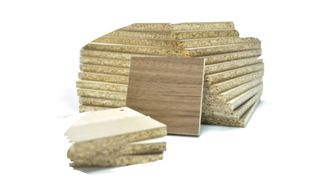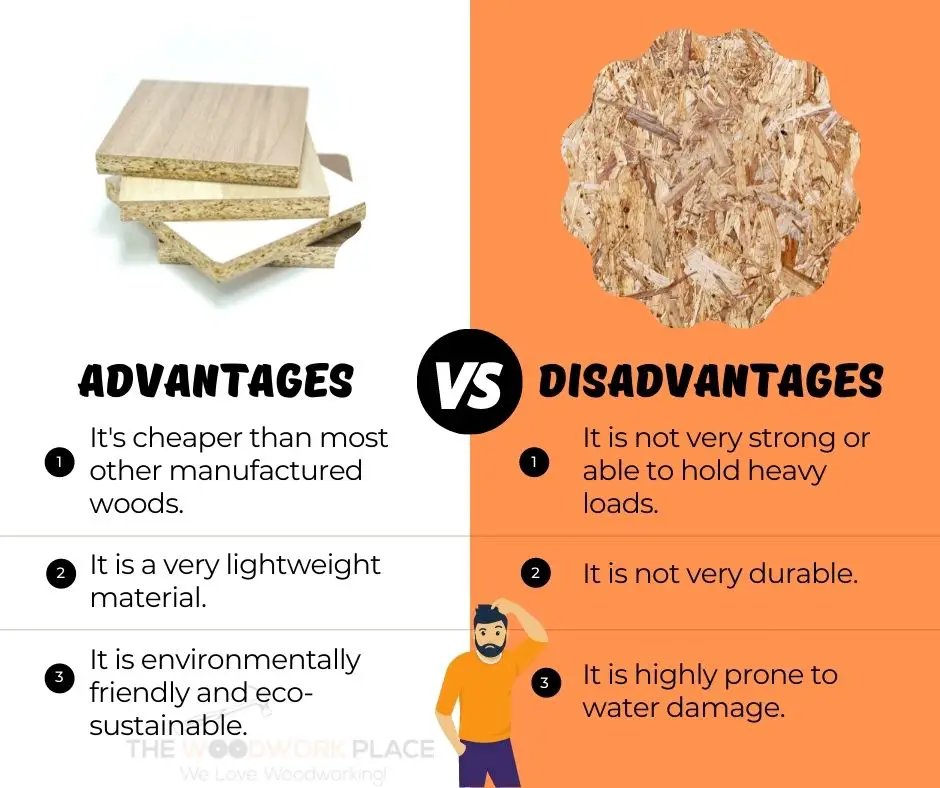When it comes to finishing natural wood, a good quality stain coat can be more than enough to make that lumber look great.
But when it comes to manufactured woods, (such as Plywood and MDF), applying a stain can sometimes be a little bit more tricky.
Let’s take Particleboard, for example. This engineered wood is made up of a hodgepodge of wood chips and glue all pressed together.
It’s not as strong as Plywood or MDF, but its smooth surface does make for a more lovely looking board.
However, if you want to give that surface a deeper shade, can you stain particle board darker?
Provided that you apply a sealer first, then yes, you can stain particle board. However, make sure you use a semi-transparent stain. Particle board is a very porous material, in that it has lots of tiny holes that easily allow for moisture to soak in. If you were to use a solid stain product, the stain will soak through the particle board and cause it to swell.
However, semi-transparent stains are made up of a blend of stain and paint. This type of stain will soak into the wood, but not as much as a solid stain product (thus reducing the chances of swelling). And the paint in the blend will coat the outside of the particleboard, giving it a rich coat of color.
But is a stain coat really your best option when it comes to making particle board look better? And how should you best go about sealing particle board in the first place?…

This post may contain affiliate links to products that we receive a commission for (at no additional cost to you). Learn more here.
So, How Can I Make Particle Board Look Better?
Well, first off, it is worth noting that particle board (also known as chipboard) takes to moisture like a duck to water. So any water-based sealant, paint or finish is pretty much off the table.
You see, if moisture gets into particle board, it will swell. In fact, if enough moisture gets into it, that board could begin to fall apart and disintegrate.
Related Post: Just What Is Manufactured Wood Anyway?
So, if you want to make the surface of particle board look great, then your first step will be to prevent moisture from getting in. You’ll do this by sealing up that surface with an oil-based (or latex-based) primer.
And avoid using water-based primers, due to the fact that these can cause the board to swell and warp.
Related Post: What To Do When Solid Wood Cabinet Doors Start Warping (Solved!)
After you’ve sealed the surface of particle board, you can go ahead and apply an oil or latex paint. Or you can simply opt for a semi-transparent stain or even a gel stain.
Cabot have one of the best semi-transparent stain products on the market. And it comes available in a range of colors, from Dark Walnut, to Pecan, to even Burnt Hickory.
What Is ‘Gel Stain? Gel stain is a type of stain that sits on top of wood. Unlike regular wood stains – which work by soaking into lumber – gel stains coat the surface of wood, just like paint.
What Will Happen If You Stain Particle Board?
If applied over a primer coat, then the right type of stain will change the color of particle board into a deeper more natural wood-like hue.
And as it soaks into those particle board wood chips, it can help to repel moisture from getting in under the surface and into the board.
But make sure you use a light touch and apply a thin coat onto the board. Too much stain, even a semi-transparent one – could end up soaking and swelling particle board.

But, Can You Stain And Seal Particle Board Easily?
Particle board is easy to seal and stain. The only time it becomes difficult is if you don’t prep the wood first (with a sealant coat), or if you are attempting to re-stain a piece of particle board furniture.
Wait A Minute… Can I Stain Particle Board Furniture From Ikea?
Typically, whenever the question of staining particle board comes up, it is usually because someone wants to change the look of an already finished furniture piece.
Here’s the thing, staining ‘unfinished’ particle board is easy. However, once particle board is finished – and sometimes even laminated over – it is very tricky to stain.
Related Post: What You Need To Know About Sealing A Particle Board Countertop
You will need to sand down the particle board first, and strip off that top sealant. And even then, if you were to apply a stain, it may not soak evenly into particle board. And why is that? Well, because those porous holes have already been filled with a sealant in the first place.
In other words, if you want to ‘stain’ over IKEA furniture, your only option is to use a Gel Stain product. You will still need to sand down the surface first though. However, the gel stain will do a decent job at coating that board evenly with color.
For a simple guide to using gel stain on manufactured wood, (like particle board), check out Leah Thrifted Nest’s quick video below:
Can You Stain Particle Board Cabinets? Or Are They Too Hard To Stain?
If the cabinets are unfinished, then yes, you can stain them.
You will need to use a semi-transparent stain product. And you must first apply a primer directly onto the unfinished particle board.
Can You Stain Particle Board Stair Treads?
No, since stair treads are formed from finished laminated particle board. So, it will be too difficult to remove that laminate.
And, worse still, the stain won’t soak evenly into the particle board underneath. This is because that finished particle board will already have had primer soaked into it. And the primer will block your fresh stain coat from soaking evenly.
So To Sum Up…
If you want to spruce up particle board, then giving it a light coat of semi-transparent stain will do in a pinch.
Just be sure to use an oil-based stain, as any water-based product will only cause particle board to swell up.



